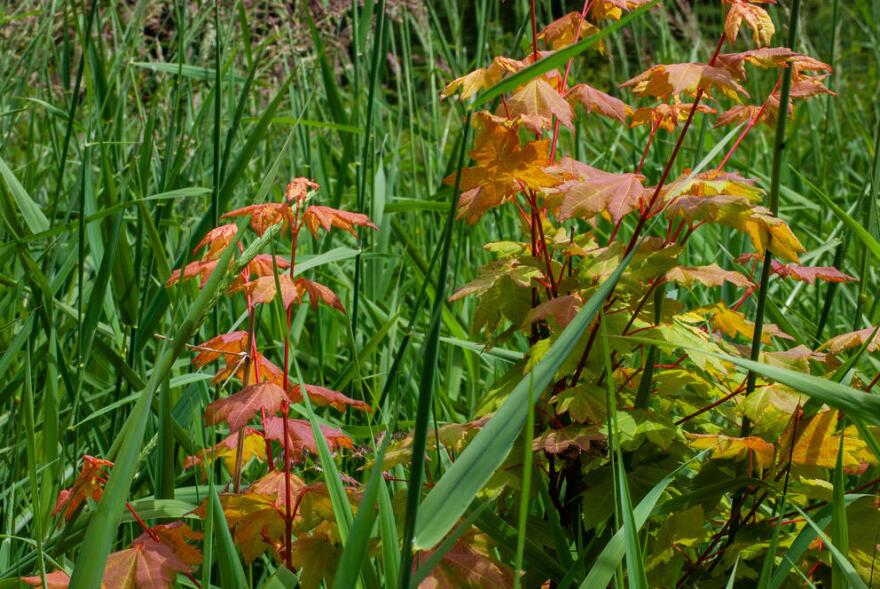When Dave New inherited a 160-acre property outside of Arlington in 2008, he didn’t think of it as anything more than a family garden surrounded by a forest.
“When we started this whole process, I would have been just as happy to not do anything to the woods up here, just [let it] literally take care of itself,” said New, who at the time worked in Seattle as a civil engineer. “Having taken the classes and whatnot, I learned that you need to manage forests in Western Washington, you can’t just let things go on their own.”
Without intervention, aging trees, particularly shorter-lived species like alder, die off. So he cut them, selling the timber to a nearby mill to cover costs. Now, 15 years later, the work continues, preparing for the next cycle of harvesting.
Small-forest landowners and tree farmers like New manage 15% of the state’s forested acres. For New, the feasibility of harvesting is a worry as environmental initiatives increasingly emphasize preserving trees for carbon sequestration, a process in which trees capture and store carbon dioxide from the atmosphere. He and others feel disadvantaged in accessing emerging markets amid a struggling timber industry.
Meanwhile, carbon sequestration in Washington has remained a climate priority for government agencies and conservation groups as a means to reduce the amount of greenhouse-gas emissions, though the future is uncertain. This November, voters will decide the fate of the Climate Commitment Act, which dedicated money to some of these efforts, and elect a new Commissioner of Public Lands.
The Commissioner of Public Lands will determine the future of the Department of Natural Resources’ Carbon Project, which identified 13,000 acres of public forest land to potentially set aside as a carbon-absorbing solution to help address climate change.
For many, this tension around where and what the timber industry can harvest echoes the Pacific Northwest’s “timber wars” of the late 1980s and 1990s over the spotted owl and other issues. That conflict fundamentally redefined forest management and led to economic turmoil for those whose livelihoods depended on the mills.

Legacy forests
What sets Washington apart from neighbors like Oregon is its higher proportion of state-owned lands compared to federal lands. This allows for more localized control and tailored strategies, like the Carbon Project, which the Department of Natural Resources introduced in 2022. The project introduced a new way for Washington to generate revenue from public land through carbon sequestration projects, in which developers manage forests to capture carbon and sell credits to offset emissions.
Under the direction of the commissioner, parcels of legacy forests old enough for harvesting were identified and set aside. The definition of “legacy forests” varies among stakeholders, but it most often refers to trees that are younger than old growth but have been steadily maturing since World War II.
However, because the project has no formal legal designation, this decision is not binding; a future Commissioner could reverse it, open forests for harvest or repurpose them for other uses — especially since no projects have yet been launched.
“At this point, everything is just on pause,” said the Department’s policy director Csenka Favorini-Csorba. “We are still doing work on our side to explore potential possibilities, so it’s not dead, but project developers are not chomping at the bit to get involved.”
The Carbon Project has faced several barriers to getting off the ground. Currently, the department can use commercial land leases only for carbon projects.
Legislation introduced last session sought to allow direct revenue from credits, instead of relying on project developers to contract. However, the bill did not pass.
And there is 2-year-old pending litigation from the American Forest Resource Council, a trade association that believes the Department should have conducted an environmental impact statement before setting aside state forest land. In June, a Thurston County Superior Court judge ruled in favor of the Department, but the Council has since filed an appeal.
“Considering there [are] very little, negligible, timber harvests on federal land in Washington … there is only so much that private forest lands can provide to sustain the infrastructure. We really depend on the DNR harvest program to do what we do,” said American Forest Resources Council public affairs director Nick Smith.
So far, no sawmills in Washington have closed, according to Smith. But if they were, the economic impact would trickle down from large timber companies to small-forest landowners, who depend on the same infrastructure for their incomes and land management needs.
The timber wars and the spotted owl
In 1994, deep divisions between environmentalists and the timber industry, known as the timber wars, resulted in the federal Northwest Forest Plan.
Upon the plan’s conception, its design centered on the protection of the endangered spotted owl and old-growth forests in the Pacific Northwest. While the plan achieved its core ecological goals, environmentalists recognize it led to significant hardship for logging-dependent communities. The U.S. Forest Service is reviewing and amending the plan to reflect changes in the decades since it was written.
“There’s a lot of trauma with the way that the spotted-owl wars played out, and it didn’t go away, even though the decisions were on Forest Service land over 30 years ago,” said Paula Sweden, policy director for Northwest Conservation, an organization committed to conserving local wildlands and wildlife. “And we don’t want to do that [with new policy].”
To try to avoid history repeating itself, policymakers are turning to science. New research from the U.S. Department of Agriculture found that extending the harvest cycle on intensively managed lands from 35 to 70 years could double the carbon stored in live trees.
However, the researchers noted that their findings differ from those of other studies, which emphasize the importance of allowing trees to live on as old-growth, typically over 100 years old, as mature forests capture the most carbon.
“If you look at a landscape scale, you can do both,” said Sweden, who believes in a balance of keeping forests that are old-growth in tandem with those that are managed for timber.
Logging ancient trees releases significant emissions that would take a long time to offset with new growth, even with fast-growing trees that sequester carbon effectively, she said. However, sustainable forestry in younger forests also plays an important role, as it continually increases carbon storage by planting, harvesting and using the wood in building materials, rather than letting it die and decompose.
Sweden said it’s important to balance the advantages of old growth and keeping jobs.
“Ask the question, ‘How do you optimize?’” said Sweden.

Shared goals
An emerging land management approach called climate-smart forestry offers unique advantages for Pacific Northwest trees like Douglas fir by combining carbon sequestration with timber harvesting.
“West of the Cascades is the prime place to produce long-lived wood products, because we’re essentially the best in the world at it. We have the ideal climate, strong environmental laws and a native species perfectly suited for this purpose,” said Elaine Oneil, director of science and sustainability for the Consortium for Research on Renewable Industrial Materials, which represents several institutions that analyze the environmental impact of producing wood materials.
Oneil is also the director of the Washington Farm Forest Association, which managed the Small Forest Landowner Carbon Workgroup requested by the state legislature. In June, the state Department of Natural Resources submitted the work group's report and recommended policies to help them participate in solutions based in natural spaces, like forests. Among the proposals was the introduction of financial incentives to support climate-smart forestry.
“This idea of financial resources is to be able to reach people where they are at and help them understand both the value that they have and the opportunity,” said Oneil.
The Climate Commitment Act established a Natural Climate Solutions Account, allocating $455.3 million of the Act’s revenue to this fund in the state’s latest biennial budget. Already, the Account has funded studies and work groups, and supported Indigenous nations in carbon sequestration efforts. If the Act is repealed this November by Initiative 2117, as proposed by groups who claim it unfairly impacts fossil-fuel industries and gas consumers, that funding will disappear. That initiative would also eliminate the cap-and-invest program that allows the Department of Ecology to manage carbon emissions. Last year, the Department adopted a forestry protocol from California that enables carbon sequestration projects to qualify under the cap-and-invest system.
Insufficient financial and technical support limits small-forest landowners’ ability to participate in the carbon offsets market, forcing them to rely on existing revenue streams to protect their property from rapid urban expansion, according to the Carbon Workgroup’s report.
New has already faced this with his tree farm.
In the early days after the property was passed down, New’s family considered selling it. They even had a contract with a developer who wanted to transform it into 60 homes, but the deal fell through.
Since then, New, now retired from his engineering job, has turned to his small timber harvest to help pay for the land management. He also heavily relies on support from his local conservation district and the state Department of Natural Resources.
Soon, New’s daughter will take over, navigating the same systems. In addition to their meticulous management, the family also accounts for growth in a way that fosters their connection to the land. New points to a conifer he calls their family tree — one they planted together when his grandson was just a year old.
“Every spring, we come here and we take our picture in front of this tree,” said New. “Every year, and the pictures of the grandkids and the trees keep getting bigger.”
Visit crosscut.com/donate to support nonprofit, freely distributed, local journalism.






